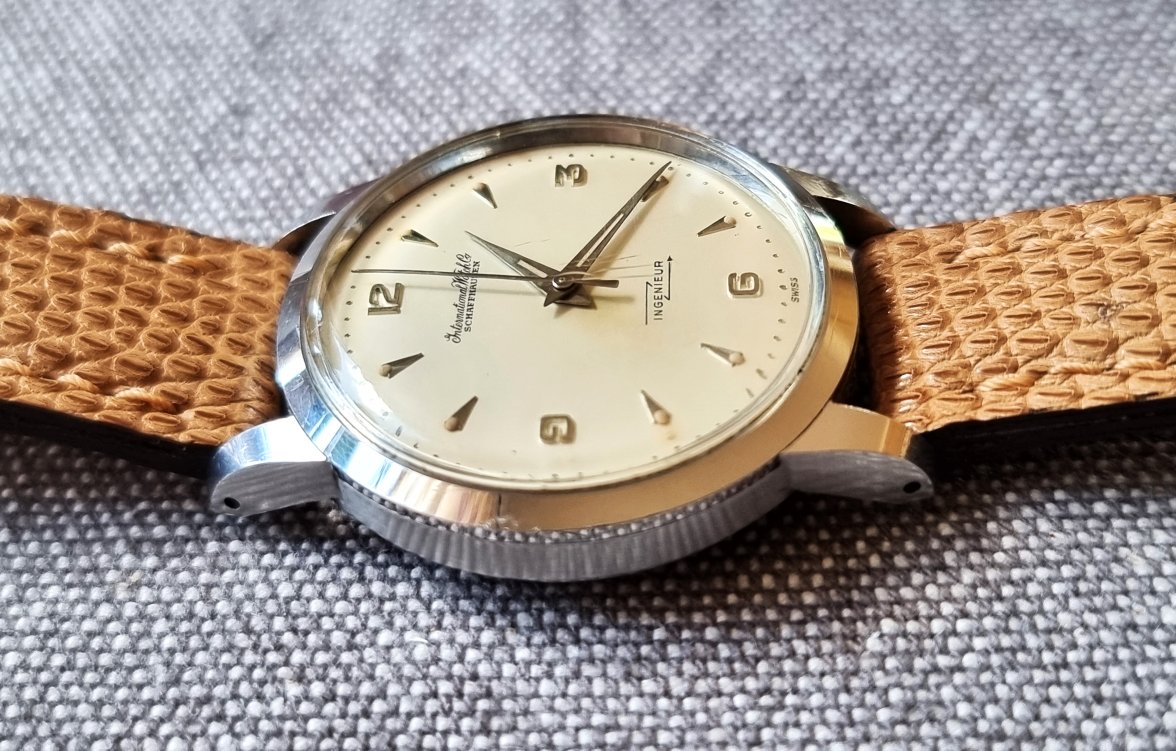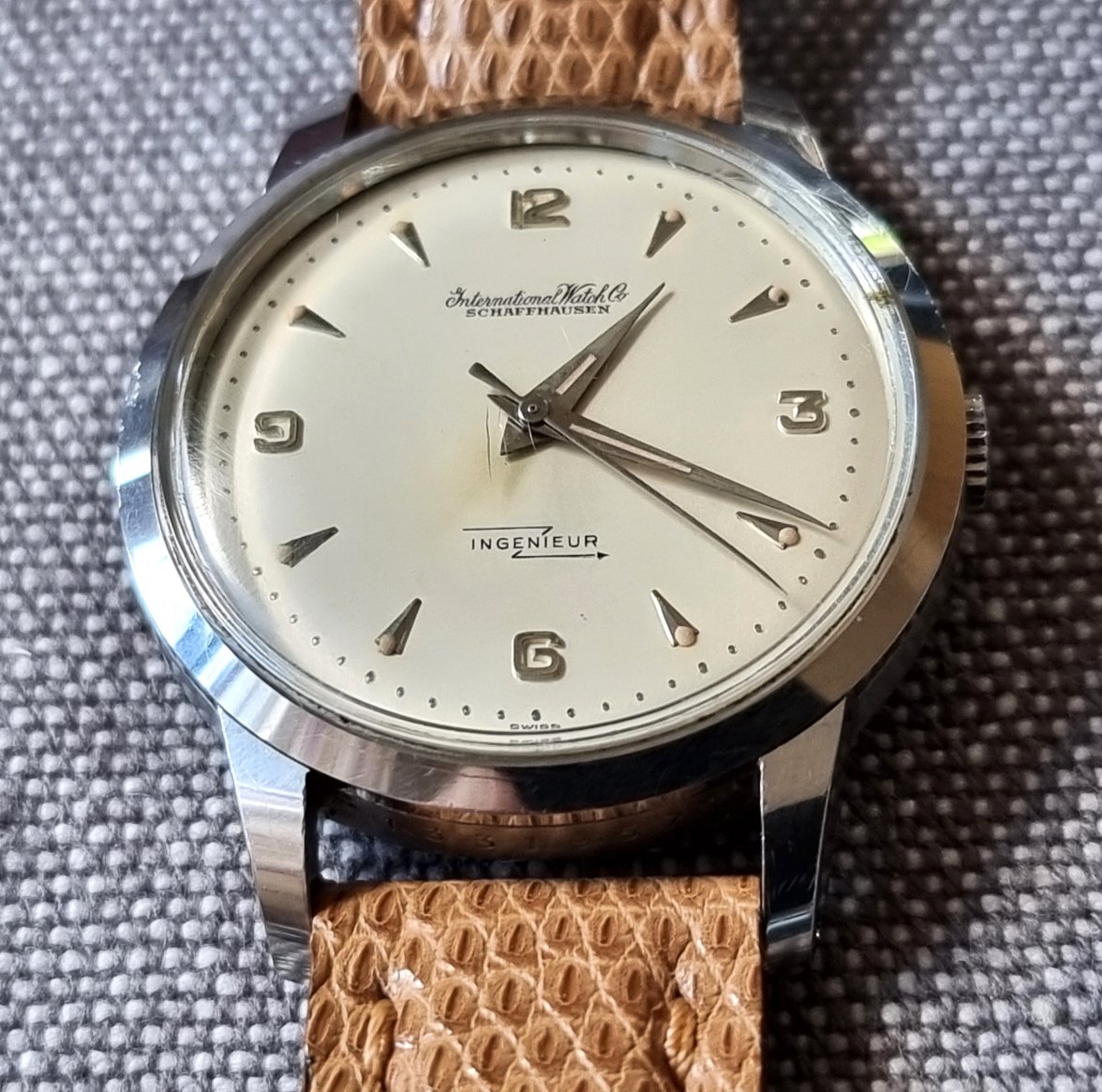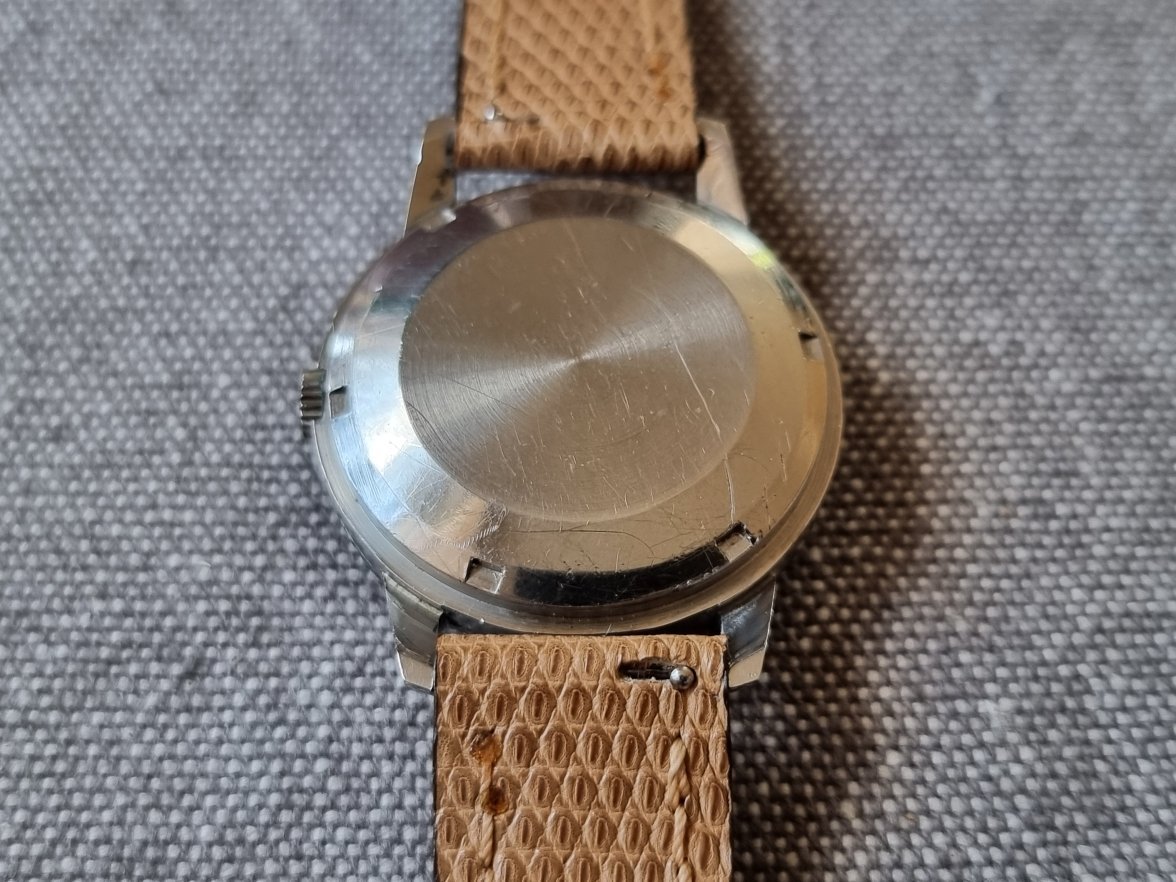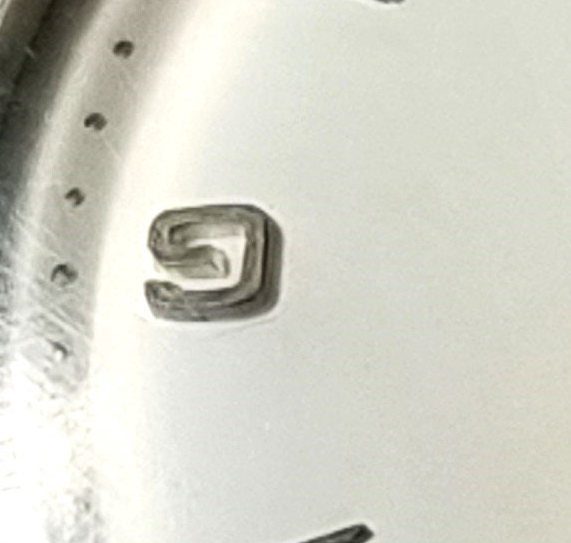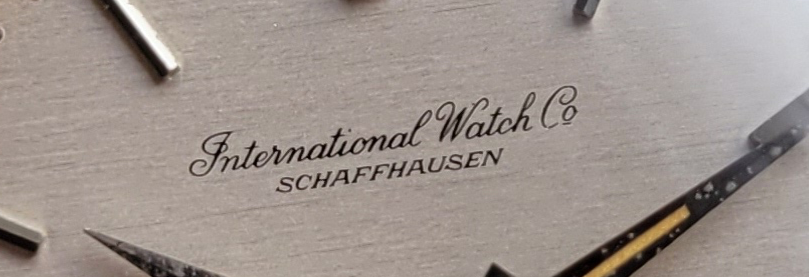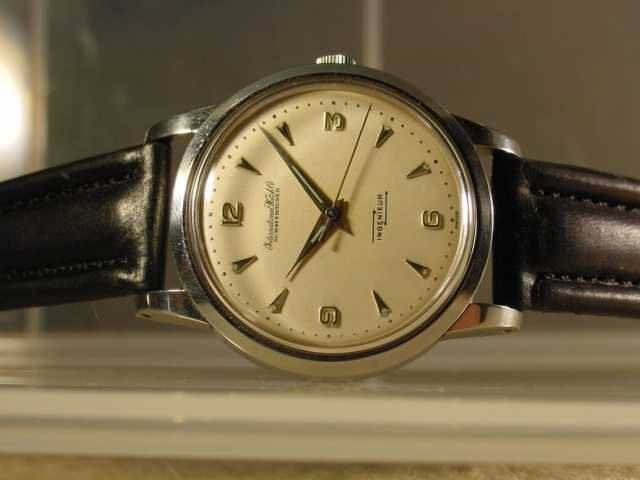Please rate- IWC 666 Ingenieur, cal 852
Tony C.
··Ωf Jury memberI owned the same dial variation many years ago. I see nothing wrong with the markers, but believe that the dial was either refinished, or was a later service replacement.
Tony C.
··Ωf Jury memberNon-italicized "SCHAFFHAUSSEN; dark printing with no signs of natural fading after ~65 years; I would expect darker lume plots after ~65 years; rotor and case back show signs of significant use, which is at least somewhat dissonant with the state of the dial.
Tony C.
··Ωf Jury memberskand
·I don't see the difference where you see. The crystal at 9 o'clock is scratched and distorts the image
skand
·A few years ago, a watch with the same dial was sold at an auction in Sweden.
https://www.kalmarantiques.com.au/product/1953-vintage-iwc-ingenieur-calibre-852/
https://www.kalmarantiques.com.au/product/1953-vintage-iwc-ingenieur-calibre-852/
Edited:
Tony C.
··Ωf Jury memberI have owned several ref. 666 Ingenieurs, and seen many in person. That does not insure that all of my related opinions will necessarily be correct, of course, but I do have a fairly deep knowledge base.
While it is true that not all vintage IWC watches featured italicized "SCHAFFHAUSSEN, an extremely high percentage, at least, of ref. 666 Ingenieurs did.
The fonts on yours are also thicker than what was typical of the early Ingenieurs, and feature more pronounced serif style. There are other differences in the styles as well, notably the W in Watch. The finer version typically seen on the early 666 is clearly different. You can compare the two below.
As for the second example to which you linked, it is superficially supportive of possible originality. But I'm not convinced of its originality, either, in part because mine had the typical signature. It is possible that there were a very small number of anomalies, but given all of the evidence of hundreds of photos of ref. 666 dials, and the consistent style seen in period advertising material, I'm yet to be convinced.
While it is true that not all vintage IWC watches featured italicized "SCHAFFHAUSSEN, an extremely high percentage, at least, of ref. 666 Ingenieurs did.
The fonts on yours are also thicker than what was typical of the early Ingenieurs, and feature more pronounced serif style. There are other differences in the styles as well, notably the W in Watch. The finer version typically seen on the early 666 is clearly different. You can compare the two below.
As for the second example to which you linked, it is superficially supportive of possible originality. But I'm not convinced of its originality, either, in part because mine had the typical signature. It is possible that there were a very small number of anomalies, but given all of the evidence of hundreds of photos of ref. 666 dials, and the consistent style seen in period advertising material, I'm yet to be convinced.
Edited:
skand
·I have owned several ref. 666 Ingenieurs, and seen many in person. That does not insure that all of my related opinions will necessarily be correct, of course, but I do have a fairly deep knowledge base.
While it is true that not all vintage IWC watches featured italicized "SCHAFFHAUSSEN, an extremely high percentage, at least, of ref. 666 Ingenieurs did.
The fonts on yours are also thicker than what was typical of the early Ingenieurs, and feature more pronounced serif style. There are other differences in the styles as well, notably the W in Watch. The finer version typically seen on the early 666 is clearly different. You can compare the two below.
As for the second example to which you linked, it is superficially supportive of possible originality. But I'm not convinced of its originality, either, in part because mine had the typical signature. It is possible that there were a very small number of anomalies, but given all of the evidence of hundreds of photos of ref. 666 dials, and the consistent style seen in period advertising material, I'm yet to be convinced.
Thanks for your contribution. I also asked a question on the vintage IWC collectors forum and got photos of a 666 watch, cal 852 with the same dial. Apparently this is an early version, and the fact that the watch looks too good for its 70 years makes me want to find a new dial. This is a watch from the IWC forum
Tony C.
··Ωf Jury memberYes, it is an early dial variation.
Tony C.
··Ωf Jury memberAgain, to be clear, there is a possibility that the dial is original.
There is another difference between this early dial variation and the vast majority of subsequent ref. 666 dials that is worth noting: the indices are embossed, rather than having been "applied". Embossing is a cheaper process, as applied indices are, with rare exceptions, more finely sculpted, more robust (either steel or gold), and make a higher-class impression to the eye.
The related dial surfaces are also finer in the later variations, including "sunburst" styles.
The example of your early reference that I owned was in excellent condition for its age, but I ended up selling it and replacing it with a later dial variation in part because the dials with applied indices are more finely finished. If you have the opportunity to handle a later version in person, you should take advantage of it, and compare the two types of indices and dial surfaces.
There is another difference between this early dial variation and the vast majority of subsequent ref. 666 dials that is worth noting: the indices are embossed, rather than having been "applied". Embossing is a cheaper process, as applied indices are, with rare exceptions, more finely sculpted, more robust (either steel or gold), and make a higher-class impression to the eye.
The related dial surfaces are also finer in the later variations, including "sunburst" styles.
The example of your early reference that I owned was in excellent condition for its age, but I ended up selling it and replacing it with a later dial variation in part because the dials with applied indices are more finely finished. If you have the opportunity to handle a later version in person, you should take advantage of it, and compare the two types of indices and dial surfaces.
Mods
·There have been a few really nice ingenieurs on sales forum over the last few years that have been surprising slow sellers, where there has been no uncertainty regarding dials possibly being refinished.
I also often see these types of posts asking for opinions after a watch has been purchased, and where better alternatives were sitting available on the sales forum.
Alway best to get a second opinion prior to purchase and to take a real good look at the for sales posts, which by the very nature of the forum will likely attract critique if purporting to be something they are not.
I also often see these types of posts asking for opinions after a watch has been purchased, and where better alternatives were sitting available on the sales forum.
Alway best to get a second opinion prior to purchase and to take a real good look at the for sales posts, which by the very nature of the forum will likely attract critique if purporting to be something they are not.
skand
·Again, to be clear, there is a possibility that the dial is original.
There is another difference between this early dial variation and the vast majority of subsequent ref. 666 dials that is worth noting: the indices are embossed, rather than having been "applied". Embossing is a cheaper process, as applied indices are, with rare exceptions, more finely sculpted, more robust (either steel or gold), and make a higher-class impression to the eye.
The related dial surfaces are also finer in the later variations, including "sunburst" styles.
The example of your early reference that I owned was in excellent condition for its age, but I ended up selling it and replacing it with a later dial variation in part because the dials with applied indices are more finely finished. If you have the opportunity to handle a later version in person, you should take advantage of it, and compare the two types of indices and dial surfaces.
Now he is preparing it to be sent to the service. I love this Ingenieur even because it is not "common", its font is different from other refs. 666. Like this 135 caliber Zenith in a steel captain's case, of which only 50 pieces were issued, according to experts. Thank you again for sharing your knowledge
skand
·I'm not sure I understand this. The watch seems to have normal aging for 70 years, including radium burn. And why would you want to find a new dial if you believe it to be original?
This is a linguistic mistake. I was told on the IWC Forum that it looks too nice, so there may be comments about the service dial or the dial being repainted, but I don't have to worry about it
- Posts
- 211
- Likes
- 124
drster
·This watch looks good to my eyes. I don't have the expetise of others here but even those experts are unable to give a definitive answer. I think there is some difficulty judging from pictures vs. being able to closely examine in person.
skand
·Tony C.
··Ωf Jury memberThere was never any doubt that the dial variation existed, in fact I mentioned in my first post that I owned one.
The questions revolved around whether or not the dial was original, refinished, or a service replacement, and an advertisement does not shed any light on the answer to those questions.
The questions revolved around whether or not the dial was original, refinished, or a service replacement, and an advertisement does not shed any light on the answer to those questions.
skand
·There was never any doubt that the dial variation existed, in fact I mentioned in my first post that I owned one.
The questions revolved around whether or not the dial was original, refinished, or a service replacement, and an advertisement does not shed any light on the answer to those questions.
The watch is currently in service, there are photos without the glass and with the clean glass replaced. Will anyone have the courage to say that the dial has been repainted?

